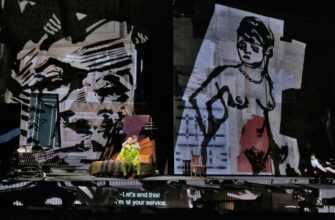Before any golfer, amateur or professional, dares to step onto the hallowed, albeit notoriously challenging, Bethpage Black Course in Farmingdale, New York, they are greeted by a stark warning. It’s not merely a suggestion; it’s a pronouncement: “WARNING — Bethpage Black is an extremely difficult course which we recommend only for highly skilled golfers.” This weekend, as the 45th Ryder Cup unfolds, this omen takes on a profound significance, setting the stage for one of golf’s most dramatic spectacles.
- The Paradox of the Public Beast
- The Ryder Cup Anomaly: Seeking Birdies on a Beast
- A Hole-by-Hole Strategic Blueprint
- The Opening Salvo: Birdie Opportunities and Subtle Threats (Holes 1-4)
- Hole 1 – Par 4, 397 yards
- Hole 2 – Par 4, 389 yards
- Hole 3 – Par 3, 210 yards
- Hole 4 – Par 5, 517 yards
- Bethpage Bares Its Teeth: The Heart of the Challenge (Holes 5-9)
- Hole 5 – Par 4, 478 yards
- Hole 6 – Par 4, 408 yards
- Hole 7 – Par 4, 524 yards
- Hole 8 – Par 3, 210 yards
- Hole 9 – Par 4, 460 yards
- The “Meat” of the Course: Where Championships are Forged (Holes 10-12)
- Hole 10 – Par 4, 502 yards
- Hole 11 – Par 4, 435 yards
- Hole 12 – Par 4, 496 yards
- The Homestretch: Strategic Play and Mounting Pressure (Holes 13-16)
- Hole 13 – Par 5, 608 yards
- Hole 14 – Par 3, 161 yards
- Hole 15 – Par 4, 477 yards
- Hole 16 – Par 4, 539 yards
- The Dramatic Finale: Muscle, Mettle, and Glory (Holes 17-18)
- Hole 17 – Par 3, 179 yards
- Hole 18 – Par 4, 411 yards
- The Ultimate Test Awaits
The Paradox of the Public Beast
Bethpage Black stands as a unique entity in championship golf. Unlike its exclusive, privately owned peers, this is a municipal course, one of five nestled within Bethpage State Park. Its public status meant its original designers had a distinct mandate: craft a course that would challenge, not coddle. There was no need to prioritize daily playability for a membership base; the aim was pure, unadulterated golf. Consequently, Bethpage Black emerged as a beast, demanding respect and precision from every player who attempts to conquer it.
Famed golf course architect Rees Jones, who has meticulously redesigned Bethpage on multiple occasions over the past two decades, succinctly captures its essence:
Indeed, Bethpage Black is unapologetically penal. Its narrow fairways, strategically placed trees, and formidable bunkers are not merely decorative elements but integral parts of its defensive architecture. The impending Ryder Cup will not only be a test of skill but a profound examination of strategic acumen and mental fortitude.
The Ryder Cup Anomaly: Seeking Birdies on a Beast
While Bethpage Black’s reputation precedes it, the Ryder Cup format introduces a fascinating twist. Unlike the individual stroke-play grind of a U.S. Open (which Tiger Woods famously won here in 2002), the match-play nature of the Ryder Cup often encourages a slightly “gentler” setup. The organizers, led by figures like Keegan Bradley, aim for excitement, for birdies, for dramatic swings of momentum. This means roughs might be slightly less punishing, and pin placements might occasionally offer a glimmer of hope. The irony is palpable: coaxing birdies from a course designed to deny them. Yet, even with these concessions, Bethpage`s inherent difficulty remains.
A Hole-by-Hole Strategic Blueprint
Let`s take an insider`s look at how this formidable layout is expected to challenge Team Europe and Team USA, hole by strategic hole.
The Opening Salvo: Birdie Opportunities and Subtle Threats (Holes 1-4)
The initial holes at Bethpage Black offer a curious welcome – a chance for early birdies, but with hidden perils that can quickly derail momentum.
Hole 1 – Par 4, 397 yards
The redesigned first tee, accommodating spectator stands, mitigates the traditional sharp dogleg. Players face a choice: aggressive carry over trees for a shorter approach, or a conservative iron off the tee, playing around the bend. Trees, often framing other holes, are a dramatic factor here.
Hole 2 – Par 4, 389 yards
Another birdie opportunity, a straight hole culminating in an elevated green. Players will likely lay up, opting for a full shot into a green where the base of the flag may be obscured. Avoiding the right rough is paramount due to side-hill lies.
Hole 3 – Par 3, 210 yards
Significantly lengthened since the 2002 U.S. Open, this par-3 may see back-left pin placements to encourage birdies, aligning with the Ryder Cup`s entertainment ethos.
Hole 4 – Par 5, 517 yards
This is Bethpage’s great paradox: a notoriously difficult hole for amateurs but often the easiest for professionals, playing like a par-4. Pros will likely reach near the glacier bunker with a mid-iron off the tee, aiming for a birdie. The green, pitching front to back, demands precise spin control to avoid chipping areas. Three of the first four holes present genuine birdie chances – a deceptively gentle start to a brutal course.
Bethpage Bares Its Teeth: The Heart of the Challenge (Holes 5-9)
After the initial “warm-up,” Bethpage Black truly begins to reveal its uncompromising nature.
Hole 5 – Par 4, 478 yards
This hole, reminiscent of Pine Valley`s 16th, marks where the course “starts to show its teeth.” A formidable tree line on the left blocks approaches, forcing players to flirt with an extended sandy area on the right. An elevated, undulating, and heavily bunkered green demands a “good par” rather than a hopeful birdie.
Hole 6 – Par 4, 408 yards
All about the drive. A short par-4 that dramatically drops after 280 yards. Players can opt to keep it on the ridge for a longer approach or thread the needle through a slot for a short flip shot into a green completely encircled by bunkers.
Hole 7 – Par 4, 524 yards
Converted from a par-5 to a brutal par-4 for the 2002 U.S. Open, this is famously the hole players “whine about.” Its sharp dogleg and encroaching trees on the right make the drive crucial, pushing players to flirt with the tree line for a shorter second shot. The course designer, Rees Jones, recalls a conversation with USGA director David Fay, who quipped that if players complained about this hole, they wouldn’t complain about the entire course – a testament to its singular difficulty.
Hole 8 – Par 3, 210 yards
The only hole featuring water. This downhill par-3 requires nuanced play. A back pin demands a released ball, while a front pin requires careful spin to avoid trickling into the water. Its character will shift daily with pin placement.
Hole 9 – Par 4, 460 yards
A substantial dogleg reinforced by a massive bunker on the turn. Players must carry this bunker to stay on the high side of the fairway, setting up an easier shot into a well-protected, low-profile green surrounded by more bunkers.
The “Meat” of the Course: Where Championships are Forged (Holes 10-12)
This three-hole stretch is widely regarded as the most challenging on the course, testing every facet of a player`s game.
Hole 10 – Par 4, 502 yards
Infamous from the 2002 U.S. Open for its unhittable fairway in adverse conditions (leading to Sergio Garcia`s memorable gesture to the crowd). While the fairway has been extended, it remains bracketed by numerous bunkers. It`s a tough tee shot, demanding power and precision.
Hole 11 – Par 4, 435 yards
Following Hole 10, the course changes direction, introducing varying wind conditions. This hole`s angled layout and elevated back green allow its character to be dramatically altered by pin position, ensuring a fresh challenge each day.
Hole 12 – Par 4, 496 yards
Uniquely, this is the only hole on the course that unequivocally demands a driver, requiring a carry of at least 280 yards over a cross bunker. While modern pros may be less intimidated than their predecessors, a pulled shot can still find sand. This hole is a direct challenge to a player`s longest club.
The Homestretch: Strategic Play and Mounting Pressure (Holes 13-16)
As the Ryder Cup approaches its climax, these holes offer a mix of relief and renewed intensity.
Hole 13 – Par 5, 608 yards
A genuine birdie opportunity. Despite its length and a cross bunker short of the green (which largely comes into play only from the rough), its relatively simple green ensures many red numbers.
Hole 14 – Par 3, 161 yards
Statistically the easiest hole on the course, a short par-3 with bunkers front and left. However, a narrow “tongue” on the front left creates an extremely difficult pin position, tempting aggressive plays that could easily lead to bogeys.
Hole 15 – Par 4, 477 yards
Considered the hardest hole on the course, despite a bunker-free fairway that allows players to “bomb it away.” The green is heavily contoured, with a steep front tier making the back of the green the only viable target. This elevated, three-bunkered green is a very small target, with misses right leading to a massive slope and a difficult recovery. The second shot here is critical.
Hole 16 – Par 4, 539 yards
The drive here demands strategic foresight. Visually, players might be drawn right, but two large bunkers guarding that side of the green dictate a drive to the left for the best angle of approach, especially when the pin is tucked right. This hole is a masterclass in fighting one`s own visual instincts.
The Dramatic Finale: Muscle, Mettle, and Glory (Holes 17-18)
The final two holes at Bethpage Black are designed to amplify the drama, testing nerves and skill under immense pressure.
Hole 17 – Par 3, 179 yards
A “dramatic, wonderful par three” and famously a “muscle-tightening hole.” While stands might shorten its playable length, its two-tier, heavily bunkered, and shallow green demands absolute precision. Going long or short can easily find sand, making this a pivotal stage for any match reaching this point.
Hole 18 – Par 4, 411 yards
A final birdie opportunity, but one rife with potential pitfalls. The fairway is bracketed by numerous bunkers. While a driver might be tempting, the long left bunker often encourages a lay-up for a more precise second shot into the elevated, heavily bunkered, small target green. It`s a thinking player`s finish, a characteristic top professionals like Scottie Scheffler and Rory McIlroy reportedly relish.
The Ultimate Test Awaits
Bethpage Black is not just a golf course; it`s an enduring character in the story of championship golf. Its unique blend of public accessibility and unyielding difficulty provides an unparalleled backdrop for the intense match play of the Ryder Cup. From the opening warning sign to the final putt on the 18th, every yard, every bunker, and every elevated green promises a strategic battleground. As the world`s best golfers convene, they will not merely be competing against each other, but against the very soul of Bethpage Black itself – a course designed to challenge the highly skilled, and perhaps, to reveal the truly legendary. The stage is set for an unforgettable display of golfing prowess and nerve.








